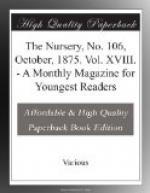Landy, disgusted with his hopeless chase, came trotting back, and at once struck in after the fawn. This one was not so fleet as the other; and by and by Landy overtook him, and tried to stop him by pushing him over with his nose. This frightened the fawn so badly, that he made direct for Tip, who was squatting in the long grass in wait for him, and rushed joyfully into his arms.
We took the bright-eyed little thing into the wagon, and by night he was so tame, that he would follow us around; and, when we lay down to sleep on the ground, I gave him a corner of my blanket for a bed. At last we got back to Thompson’s log-house, which stood near the timber; and, when we went away we gave the fawn to his two little girls. I would really like to know what ever became of it.
PERRY, O. LLOYD WYMAN.
[Illustration]
[Illustration]
The Apple Tree.
Up in the apple-tree
See the rosy cheeks;
See the balls that look like
gold;
See the crimson
streaks.
In the lovely autumn day,
Bright as in the bloom of
May,
Filled with fruit, and fair
to see,
Is
the apple-tree.
Under the apple-tree
See the rosy cheeks:
Little Ginx, the baby,
What is it he
seeks?
Ah! his tiny teeth are white,
And are eager for a bite,—
Such a tempting store to see
Is
the apple-tree.
Under the apple-tree,
Other rosy cheeks,—
Edith, Mabel, Gold-Locks,
Full of happy freaks.
Here they run, and there they run,
Shouting merrily, if one
Fallen in the grass they see
From the apple-tree.
CLARA DOTY BATES.
A COUNCIL OF HORSES.
On the large plains of South America, horses run wild in great numbers. They are caught by means of a lasso, which is a rope with a noose at one end. This is thrown with great dexterity over the neck of the wild horse.
The artist has called the picture which we here present “A Council of Horses.” Do they not look as if they were taking advice of one another? The white horse, with his erect neck and head, seems to be the leader, or chief. He is willing to hear what the others may have to say; but he means that they shall follow him, after all.
And can horses really make known their wishes to one another? It would almost seem so, though we cannot prove it. Wild horses choose their own chiefs, and these give the signal of departure. If any extraordinary object appears, the chief commands a halt. He goes to discover what it is, and, after his return, gives, by neighing, the signal of confidence, of flight, or of combat.
Five sorts of neighing may be noticed: that of joyfulness, of desire, of anger, of fear, and of sorrow. A feeling peculiar to the horse is emulation. Whoever has witnessed a horse-race can understand the ardor, vehemence, and struggle for victory, which excite the energies of both horses and men. The animals have often tried to hold their rivals back by the teeth. This has been known to happen when the horses are left entirely to themselves, as on some of the Italian race-courses, where the horses run without riders.




